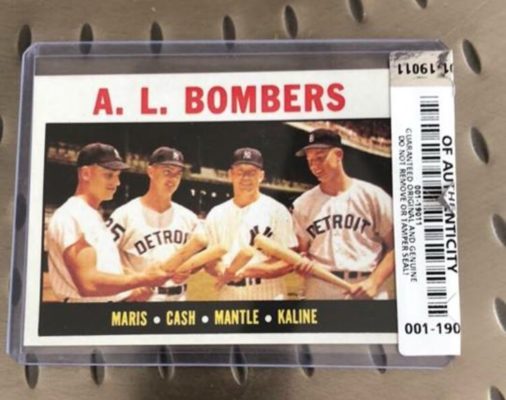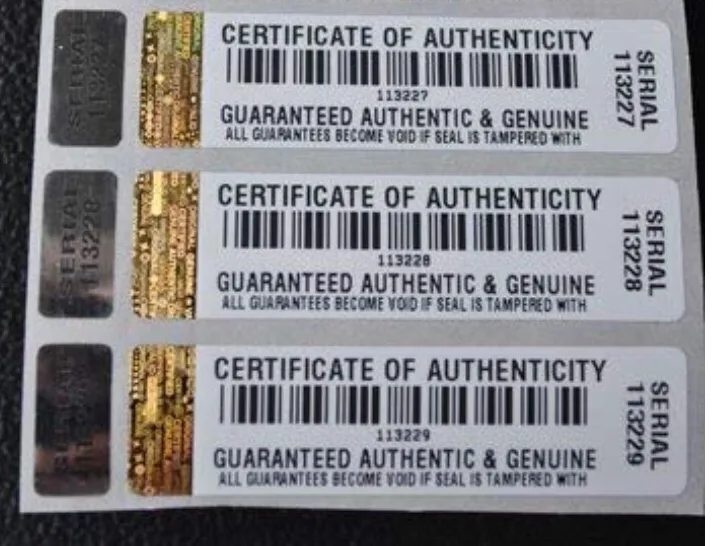Inside the Pack: How to Tell a Counterfeit Card
Over the last few weeks, I’ve noticed a good amount of counterfeit cards being passed off as the real deal thanks to a bogus “certificate of authenticity” sticker. The sticker is very official-looking: it has a hologram, what appears to be a unique number, and a strongly worded statement guaranteeing the card’s authenticity — if the seal isn’t broken.

The only problem is that the cards inside aren’t real, and the only way to prove that would be to break open the seal. Anyone can buy these labels in bulk on Amazon. They cost less than 20 cents each, a reasonable investment for a nefarious seller who is going to turn a worthless card into a card worth $50 or more. Although the wording on the sticker seems on the surface to be legally binding, it is worded in such a way that it means absolutely nothing.
Determining whether an ungraded card is real is a difficult task, and there are no shortcuts to doing so. However, you can make an informed decision that will help you determine if the card is likely a reprint. To be clear, there are still very good counterfeits that may pass the test and need further inspection to determine their authenticity. But the items on this checklist will help you raise any red flags so that you can immediately decide if the card in question is fake.
- Who is guaranteeing its authenticity? A certificate of authenticity is only as good as the person or company standing behind it. In the example of the fake authenticity stickers shown above, the wording says that the card is guaranteed, but by whom? If you buy it from a dealer online or in person and the card turned out to not be authentic, the dealer would very likely say that the sticker did not belong to them and was placed there before they purchased the card. For this reason, the guarantee is worthless. Similarly, anyone with a computer can print a certificate of authenticity and include it with a card or an autograph. Therefore, you have to determine if the seller is reputable and if you believe they will issue you a refund should the item not be authentic. In these cases, it’s worth it to stick with the major companies: PSA, Beckett, and SGC for cards: PSA/DNA, JSA, Mounted Memories, UDA, and Steiner for autographs and memorabilia.
- Be wary of impressive sounding titles or fancy looking guarantees. In general, if the guarantee does not come from one of the companies labeled above, there is an immediate red flag. That does not mean that item is definitely fake, but it means you should pay closer attention to the item. Be cautious of very fancy titles along the lines of “forensic document examiner”. People holding these titles have been banned from eBay listings because of their propensity to pass off fake autographs. When it comes to cards, just because it is in a graded card slab does not mean it’s automatically real. If the slab is not from one of the companies listed above, it should be treated as a raw card and inspected very carefully. Even companies you have heard of such as Global/GAI or Sports Collectors Digest/SCD have been known to pass off fake cards as real. There are also many people who pass cards off in holders that look similar to PSA holders in order to trick the buyer. Again, it is certainly in the realm of possibility that these items could still be real, but they should be treated as questionable until you can prove they are real.
- Can you inspect the item closely? One of the big red flags with the stickers shown in this post is that removing the card in order to inspect it would render it to be no longer guaranteed, according to the wording on the sticker. This poses a big problem, as the best way to determine the cards authenticity is to inspect it. Hold it in your hand; does it feel like a real card of that era? Vintage cards should not be glossy. Cards from the 50s and 60s should not be paper thin or very thick. All four corners should not be perfectly rounded. Are there patterns that look like it was intentionally stained to look old? Does it smell like old paper? Does the printing on it look too good to have been done at the supposed time of issue? When you hold a light source up to the card, does the light shine through? If you compare the card to another card from the same set, do they seem to be the same? These are all questions that you can answer when you hold a raw card in your hand. You should be wary of any card that raises one of the red flags above and also any seller does not let you inspect the card closely.
Of course, the best way to determine a card’s authenticity is to use a reputable third party grading service — PSA, SGC, or Beckett. But short of that, the items in the list above can help you.




